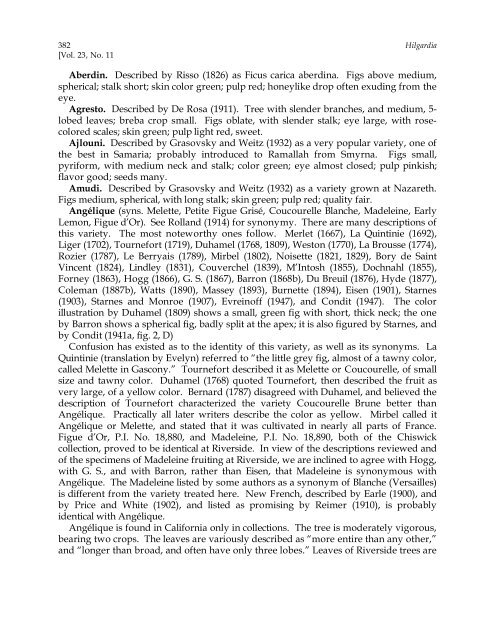Fig Varieties: A Monograph - uri=ucce.ucdavis
Fig Varieties: A Monograph - uri=ucce.ucdavis
Fig Varieties: A Monograph - uri=ucce.ucdavis
You also want an ePaper? Increase the reach of your titles
YUMPU automatically turns print PDFs into web optimized ePapers that Google loves.
382 Hilgardia<br />
[Vol. 23, No. 11<br />
Aberdin. Described by Risso (1826) as Ficus carica aberdina. <strong>Fig</strong>s above medium,<br />
spherical; stalk short; skin color green; pulp red; honeylike drop often exuding from the<br />
eye.<br />
Agresto. Described by De Rosa (1911). Tree with slender branches, and medium, 5-<br />
lobed leaves; breba crop small. <strong>Fig</strong>s oblate, with slender stalk; eye large, with rosecolored<br />
scales; skin green; pulp light red, sweet.<br />
Ajlouni. Described by Grasovsky and Weitz (1932) as a very popular variety, one of<br />
the best in Samaria; probably introduced to Ramallah from Smyrna. <strong>Fig</strong>s small,<br />
pyriform, with medium neck and stalk; color green; eye almost closed; pulp pinkish;<br />
flavor good; seeds many.<br />
Amudi. Described by Grasovsky and Weitz (1932) as a variety grown at Nazareth.<br />
<strong>Fig</strong>s medium, spherical, with long stalk; skin green; pulp red; quality fair.<br />
Angélique (syns. Melette, Petite <strong>Fig</strong>ue Grisé, Coucourelle Blanche, Madeleine, Early<br />
Lemon, <strong>Fig</strong>ue d’Or). See Rolland (1914) for synonymy. There are many descriptions of<br />
this variety. The most noteworthy ones follow. Merlet (1667), La Quintinie (1692),<br />
Liger (1702), Tournefort (1719), Duhamel (1768, 1809), Weston (1770), La Brousse (1774),<br />
Rozier (1787), Le Berryais (1789), Mirbel (1802), Noisette (1821, 1829), Bory de Saint<br />
Vincent (1824), Lindley (1831), Couverchel (1839), M’Intosh (1855), Dochnahl (1855),<br />
Forney (1863), Hogg (1866), G. S. (1867), Barron (1868b), Du Breuil (1876), Hyde (1877),<br />
Coleman (1887b), Watts (1890), Massey (1893), Burnette (1894), Eisen (1901), Starnes<br />
(1903), Starnes and Monroe (1907), Evreinoff (1947), and Condit (1947). The color<br />
illustration by Duhamel (1809) shows a small, green fig with short, thick neck; the one<br />
by Barron shows a spherical fig, badly split at the apex; it is also figured by Starnes, and<br />
by Condit (1941a, fig. 2, D)<br />
Confusion has existed as to the identity of this variety, as well as its synonyms. La<br />
Quintinie (translation by Evelyn) referred to “the little grey fig, almost of a tawny color,<br />
called Melette in Gascony.” Tournefort described it as Melette or Coucourelle, of small<br />
size and tawny color. Duhamel (1768) quoted Tournefort, then described the fruit as<br />
very large, of a yellow color. Bernard (1787) disagreed with Duhamel, and believed the<br />
description of Tournefort characterized the variety Coucourelle Brune better than<br />
Angélique. Practically all later writers describe the color as yellow. Mirbel called it<br />
Angélique or Melette, and stated that it was cultivated in nearly all parts of France.<br />
<strong>Fig</strong>ue d’Or, P.I. No. 18,880, and Madeleine, P.I. No. 18,890, both of the Chiswick<br />
collection, proved to be identical at Riverside. In view of the descriptions reviewed and<br />
of the specimens of Madeleine fruiting at Riverside, we are inclined to agree with Hogg,<br />
with G. S., and with Barron, rather than Eisen, that Madeleine is synonymous with<br />
Angélique. The Madeleine listed by some authors as a synonym of Blanche (Versailles)<br />
is different from the variety treated here. New French, described by Earle (1900), and<br />
by Price and White (1902), and listed as promising by Reimer (1910), is probably<br />
identical with Angélique.<br />
Angélique is found in California only in collections. The tree is moderately vigorous,<br />
bearing two crops. The leaves are variously described as “more entire than any other,”<br />
and “longer than broad, and often have only three lobes.” Leaves of Riverside trees are
















![Fig Trees in North Carolina [Archive] - IDigMyGarden ... - Figs 4 Fun](https://img.yumpu.com/26905320/1/190x245/fig-trees-in-north-carolina-archive-idigmygarden-figs-4-fun.jpg?quality=85)